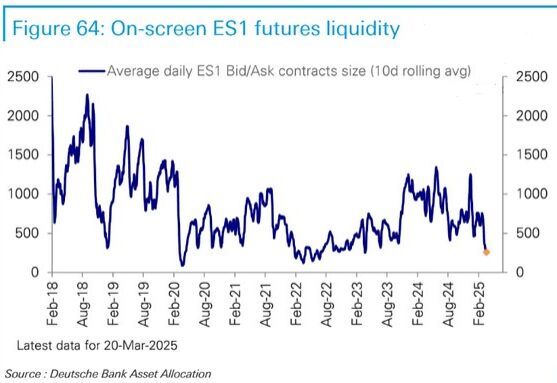
(March 26): Worries over the economic effects of the global trade war are further sapping liquidity in US stocks, creating a headache for institutional investors that could also boost volatility in broader markets.
Liquidity — the ease of buying or selling an asset without affecting its price — has been dwindling for years due to factors such as tighter regulations and the rise of automatic trading. Tariff concerns have introduced a new wrinkle, stoking gyrations in individual stocks that have made it harder for institutions to trade in size.
The phenomenon can be seen in a pair of widely tracked liquidity measures. Liquidity in S&P 500 stock-index futures, as measured in the most active contract, stands at a two-year low, data compiled by Deutsche Bank AG show. Meanwhile, the five-day moving average of Citigroup Inc’s liquidity index, which is based on futures volumes for the S&P 500, is also hovering near its lowest level in two years.
“This concerns us and it’s really frustrating,” said Rob Friesen, chief operating officer at Las Vegas-based Bright Trading. “Tariff fears exacerbate swings in individual stocks, so then you feel like you’re getting run over every time the algo trades kick in when volatility spikes.”
Low liquidity can push up the costs of portfolio hedging for traders large and small, while widening the spread between buy and sell prices until it becomes difficult for investors to determine what is fair to pay. In broader markets, it can magnify stock routs if investors aren’t able to sell shares at the desired level, forcing them to take a worse price.
Fed flag
In November, the Federal Reserve flagged the issue in its Financial Stability Report, saying “liquidity in financial markets was generally low and can become strained during periods of volatility”.
More recently, investors say the unsettled global backdrop has added to the problem by making individual stocks more volatile as traders are forced to assess how specific companies might be impacted by tariffs. A study from Goldman Sachs Group Inc showed that 74% of the S&P 500’s returns have been driven by micro factors like earnings over the last six months, well above an average of 58% in the past two decades.
Friesen and his brokers have tried to buy tech stocks beyond megacaps such as Nvidia Corp and Apple Inc, only to find that trading was thin, causing share prices of stocks they were targeting to run up. Rather than paying up, they waited until they found a better offer.
Derek Maupin, co-portfolio manager of the Hodges Intrinsic Value Fund, said his firm planned on snapping up battered small-capitalisation stocks last month but liquidity was scarce, due in part to tariff-fuelled stock moves.
“We have to wait longer to execute an order until there’s better liquidity in certain instances. We also need to be more flexible when exiting positions now,” Maupin said.
Ebb and flow
Of course, liquidity has typically ebbed and flowed throughout the years, even if the broader trend has been lower. Current conditions could ease — at least temporarily — if tariffs prove less severe than feared or economic worries dissipate.
Scott Ladner, chief investment officer at Horizon Investments, said liquidity will likely improve for both single stocks and S&P 500 futures as markets become more accustomed to tariff-related volatility.
“But until we get more details, it’s going to be really challenging for traders,” he said.
Uploaded by Arion Yeow

